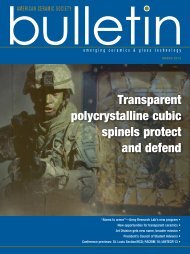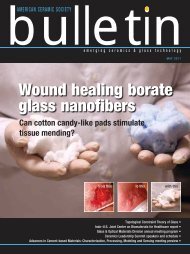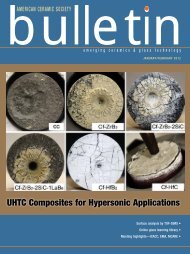AMERICAN CERAMIC SOCIETY
AMERICAN CERAMIC SOCIETY
AMERICAN CERAMIC SOCIETY
Create successful ePaper yourself
Turn your PDF publications into a flip-book with our unique Google optimized e-Paper software.
advances in nanomaterials<br />
New graphene ‘hub’ and electronics discovery create excitement in UK<br />
In early October, the United Kingdom’s<br />
Chancellor of the Exchequer<br />
George Osborne announced plans by<br />
the government to invest £50 million<br />
(about $80 million) in a new graphenebased<br />
R&D center. The center, to be<br />
called the Graphene Global Research<br />
and Technology Hub, will be located at<br />
the University of Manchester.<br />
The location in many ways is a tribute<br />
to the past and ongoing work by<br />
Andre Geim and Kostya Novoselov,<br />
who discovered graphene at the University<br />
of Manchester in 2004 and were<br />
awarded the 2010 Nobel Prize in physics.<br />
Geim and Novoselov’s pioneering<br />
work has allowed them to attract a talented<br />
team and stay at the forefront of<br />
this field, where a lot of ideas for commercialization<br />
are being brewed.<br />
Although no timetables are being<br />
proposed in regard to real commercialization<br />
opportunities, Osborne, according<br />
to a university news release, told<br />
attendees of a Conservative Party Conference,<br />
“…We will fund a national<br />
research program that will take this<br />
Nobel-prize-winning discovery from the<br />
British laboratory to the British factory<br />
floor. … We’re going to get Britain<br />
making things again.”<br />
In the same release, the university,<br />
itself, goes on to predict, “The development<br />
of the Hub will capitalize on<br />
the UK’s international leadership in<br />
the field. It will act as a catalyst to<br />
spawn new businesses, attract global<br />
companies and translate the value of<br />
scientific discovery into wealth and job<br />
creation for the UK. The center would<br />
help develop the technology to allow<br />
manufacture on a scale that would open<br />
up the promising commercial opportunities,<br />
incorporating a large doctoral<br />
training center and advanced research<br />
equipment.”<br />
To be sure, there are many other graphene<br />
research efforts, public and private,<br />
in the UK and around the world.<br />
Responding to the news about the<br />
funding for the Manchester hub, a story<br />
American Ceramic Society Bulletin, Vol. 90, No. 9 | www.ceramics.org<br />
Noble laureates Novoselov and Geim,<br />
left, along with Nancy Rothwell, president<br />
and vice-chancellor of the University of<br />
Manchester, meet with UK Science Minister<br />
David Willetts and Osborne to discuss plans<br />
for a new graphene-based R&D hub to be<br />
located at the school.<br />
at Optics.org notes, “Though it is home<br />
to the graphene discoverers, when it<br />
comes to future commercialization of<br />
the technology, the UK will face stiff<br />
competition from both competing<br />
academic institutions and many of the<br />
world’s largest technology companies.”<br />
Already several big-name companies,<br />
such as IBM, Hitachi and TDK, have<br />
received patents for novel graphenebased<br />
devices. But, as is usually the<br />
case, having a patent and having a<br />
commercial success are unrelated<br />
events. Although there is a lot of promise,<br />
there is still a long way to go in<br />
fundamental research and,<br />
at the other end of the spectrum,<br />
basic processing and<br />
application methods.<br />
Given the interest and<br />
competition, the £50 million<br />
investment could easily<br />
be dwarfed if not carefully<br />
targeted. Along these lines,<br />
the Optics.org story discusses<br />
the views of another UK graphene<br />
researcher, Karl Coleman<br />
(University of Durham),<br />
and reports, “Coleman thinks<br />
that manufacturing ought to<br />
be one of the priority areas<br />
for the future technology<br />
hub, and also points out that<br />
graphene applications go<br />
beyond the high-profile areas<br />
(Credit: Univ. of Manchester.)<br />
of electronics, displays and aerospace.<br />
‘[We] would like to see the hub include<br />
what we sometimes call the low-hanging<br />
fruits, such as capacitors, conducting<br />
inks and composites, to name just<br />
a few, that are likely to be commercialized<br />
much sooner,’ he said.”<br />
On the other hand, Geim and<br />
Novoselov do have a high-profile<br />
electronics application in mind for<br />
graphene: the elusive replacement for<br />
the silicon chip. In a paper, “Tunable<br />
Metal–Insulator Transition in Double-<br />
Layer Graphene Heterostructures,”<br />
recently published in Nature Physics<br />
(doi:10.1038/nphys2114), their group<br />
discusses the creation of double boron<br />
nitride–graphene sandwich structures.<br />
Essentially, these investigators transferred<br />
a graphene monolayer to the top<br />
of a 20- to 30- nanometer-thick BN<br />
crystal (prepared on a silicon wafer).<br />
The graphene was then covered with<br />
another BN crystal and another graphene<br />
monolayer. Both monolayers<br />
were given multiterminal shapes, individual<br />
electrical contacts and aligned<br />
identically over each other.<br />
According to the authors of the<br />
paper, the four-layer structure for the<br />
first time allowed the behavior of gra-<br />
Ponomarenko with boron nitride–graphene sandwich<br />
device.<br />
(Credit: Univ. of Manchester.)<br />
17






